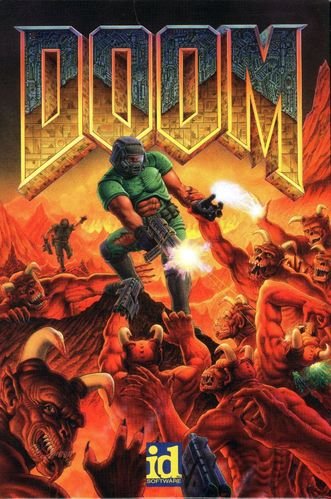
The development of Doom began in late 1992, with John Carmack writing the new game engine while the rest of id Software was finishing Spear of Destiny (the prequel to Wolfenstein 3D). When the full design phase began in late 1992, the main thematic influences were the movies Aliens and Evil Dead II, and the Dungeons & Dragons campaign the developers had been playing, where the forces of hell invaded the material world. The title of the game was chosen by John Carmack:
There is a scene in "The Color of Money" where Tom Cruse [sic] shows up at a pool hall with a custom pool cue in a case. "What do you have in there?" asks someone. "Doom." replied Cruse with a cocky grin. That, and the resulting carnage, was how I viewed us springing the game on the industry.
Id's programmers had to make use of several tricks for these features to run smoothly on 1993-vintage personal computers. Most significantly, Doom levels are not truly three-dimensional: they are internally represented on a two-dimensional plane, with height differences added separately (a similar trick is still used by many games to create huge outdoor environments). Doom also has a low-detail mode to improve frame rates on slower PCs, such as those with an 80386 processor.
Designer Tom Hall wrote an elaborate specifications document called the Doom Bible, according to which the game would feature a detailed storyline, multiple player characters, and a number of interactive features. However, many of his ideas were discarded during development in favor of a simpler design primarily advocated by John Carmack, resulting in Hall eventually being forced to resign from id Software. Most of the final level designs are those of John Romero and Sandy Petersen. The graphics, by Adrian Carmack, Kevin Cloud, and Gregor Punchatz, were created in various ways: although much was drawn or painted, several of the monsters were digitized from sculptures in clay or latex, and some of the weapons are modeled on toy guns from Toys "Я" Us. A heavy metal/ambient soundtrack was supplied by Bobby Prince.
Doom's primary distinguishing characteristic at the time of its release was its "3-D" graphics, then unparalleled by other real-time-rendered games running on consumer-level hardware. Several new features improved on those of Wolfenstein 3D:
Altitude differences (all floors/ceilings in Wolfenstein 3D are at the same height), but not sloped surfaces.
Non-orthogonal walls (all walls in Wolfenstein 3D run along a rectangular grid). However, all walls in Doom are still perpendicular to the floor and/or ceiling.
Full texture mapping of all surfaces.
Varying light levels (all areas in Wolfenstein 3D have identical lighting). This not only made each map's structure more visually authentic, but contributed to its atmosphere and gameplay by using darkness to frighten or confuse the player.
A less static architecture than in Wolfenstein 3D: platforms can move up or down, floors can be lifted sequentially to form staircases, and bridges can rise or lower.
A stereo sound system, which makes it possible to roughly tell the direction and distance of a sound's origin. The player is kept on guard by the grunting and snarling of monsters, and receives occasional clues to the locations of secret areas by hearing hidden doors open remotely.
STORY:
Doom has a simple plot; its background is given in the instruction manual, and the in-game story advances mainly through short messages displayed between the game's episodes.
The player takes the role of a marine (unnamed to further represent the person playing), "one of Earth's toughest, hardened in combat and trained for action", who has been incarcerated on Mars after assaulting a senior officer when ordered to fire upon civilians. There, he works alongside the Union Aerospace Corporation (UAC), a multi-planetary conglomerate and military contractor performing secret experiments on interdimensional travel. Recently, the teleportation has shown signs of anomalies and instability, but the research continues nonetheless.
Suddenly, something goes wrong and creatures from hell swarm out of the teleportation gates on Deimos and Phobos. A defensive response from base security fails to halt the invasion, and the bases are quickly overrun by monsters; all personnel are killed or turned into zombies
A military detachment from Mars travels to Phobos to investigate the incident. The player is tasked with securing the perimeter, as the assault team and their heavy weapons are brought inside. Radio contact soon ceases and the player realizes that he is the only survivor. Being unable to pilot the shuttle off of Phobos by himself, the only way to escape is to go inside and fight through the complexes of the moon base.
Hi! I am a robot. I just upvoted you! I found similar content that readers might be interested in:
https://doomwiki.org/wiki/Doom